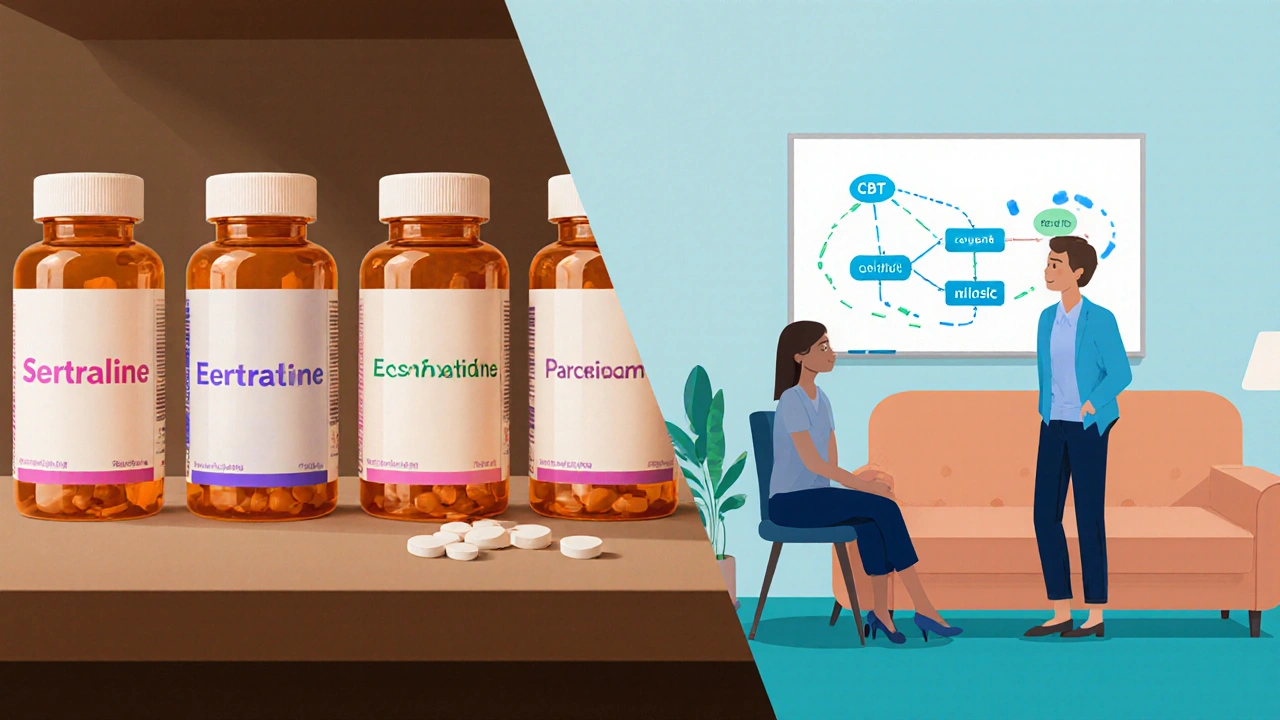SSRI Medication Selector Tool
This tool helps you identify which SSRI medication might be most appropriate for your OCD symptoms. Answer the questions below to receive a personalized recommendation based on factors like side-effect tolerance, cost, and symptom severity.
Step 1: Severity of Symptoms
Step 2: Side Effect Concerns
Step 3: Medication Interactions
Step 4: Cost Considerations
Step 5: Treatment Preference
Quick Takeaways
- Luvox (fluvoxamine) is an SSRI specifically approved for OCD, with a shorter half‑life than many peers.
- Sertraline, fluoxetine, paroxetine and escitalopram are common SSRI alternatives that treat both OCD and anxiety.
- Choosing the right drug depends on efficacy, side‑effect profile, drug interactions and personal cost considerations.
- Non‑drug options such as Cognitive Behavioral Therapy (CBT) can work alone or boost medication benefits.
- Never switch or stop a psychiatric medication without consulting a prescriber - tapering is usually required.
What is Luvox (Fluvoxamine)?
Luvox is the brand name for fluvoxamine, an selective serotonin reuptake inhibitor (SSRI) primarily prescribed for obsessive‑compulsive disorder (OCD). It was first approved by the FDA in 1994 and is marketed in more than 70 countries. The drug works by increasing serotonin levels in the brain, which helps calm the intrusive thoughts and compulsive behaviors that define OCD.
How Luvox Works and What to Expect
Fluvoxamine blocks the serotonin transporter (SERT), allowing more serotonin to linger in the synaptic gap. This action typically reduces OCD symptoms after 8‑12 weeks of steady dosing. Because Luvox has a half‑life of about 15‑20hours, it is taken once daily, usually in the evening to avoid daytime drowsiness. Common side effects include nausea, insomnia, dry mouth and mild sexual dysfunction. Unlike some SSRIs, Luvox can interact with certain antidepressants (e.g., MAOIs) and a wide range of over‑the‑counter medications, so a thorough medication review is essential.

Popular Alternatives to Luvox
When Luvox isn’t a good fit-whether due to side effects, cost, or drug interactions-doctors often turn to other SSRIs or evidence‑based therapies. Below are the most frequently considered options.
- Sertraline (Zoloft) - a broad‑spectrum SSRI approved for OCD, major depression, panic disorder and PTSD.
- Fluoxetine (Prozac) - the first SSRI on the market, known for a longer half‑life and activating profile.
- Paroxetine (Paxil) - often chosen for its strong anxiolytic effect but linked to higher weight‑gain risk.
- Escitalopram (Lexapro) - a newer SSRI praised for fewer side effects and good tolerability.
- Cognitive Behavioral Therapy (CBT) - a non‑pharmacologic approach that teaches patients to challenge obsessive thoughts and develop healthier coping skills.
Side‑Effect Snapshot
Every medication has trade‑offs. The table below lines up the most common side effects reported in clinical trials and post‑marketing surveillance for each drug.
| Medication | Typical Dose (Adults) | Half‑Life | Top 3 Side Effects | Average Monthly Cost (US$) |
|---|---|---|---|---|
| Luvox (Fluvoxamine) | 50‑300mg | 15‑20h | Nausea, insomnia, sexual dysfunction | ≈45 |
| Sertraline | 50‑200mg | 26h | Diarrhea, dizziness, sexual dysfunction | ≈30 |
| Fluoxetine | 20‑80mg | 4‑6days | Insomnia, anxiety, dry mouth | ≈25 |
| Paroxetine | 20‑60mg | 21h | Weight gain, sexual dysfunction, constipation | ≈35 |
| Escitalopram | 10‑20mg | 27‑32h | Nausea, fatigue, sexual dysfunction | ≈40 |
| CBT (weekly sessions) | - | - | Initial anxiety, time commitment, occasional emotional discomfort | ≈120 (per 12‑week course) |
How to Choose the Right Option
Here’s a quick decision‑making flow you can run through with your prescriber:
- Severity and type of symptoms. If OCD is the primary issue, Luvox or sertraline have the strongest evidence base.
- Side‑effect tolerance. If you’re sensitive to insomnia, fluoxetine’s activating profile might be a deal‑breaker, while escitalopram tends to be more sedating.
- Drug interactions. Luvox’s metabolism via CYP1A2 and CYP2D6 means it can clash with certain antibiotics and anti‑psychotics. Paroxetine, on the other hand, is a potent CYP2D6 inhibitor.
- Cost and insurance coverage. Generic sertraline and fluoxetine are usually the cheapest; brand‑name Luvox can cost up to 50% more.
- Non‑pharmacologic preference. Some patients start with CBT alone, especially if they worry about medication stigma.
Combine these factors, discuss them openly, and you’ll land on a plan that matches your lifestyle and health goals.

Switching or Starting a New Medication
Never make a change on your own. A typical taper‑and‑switch protocol looks like this:
- Reduce the current SSRI dose by 25% every 1‑2 weeks under medical supervision.
- Introduce the new medication at a low starting dose once the previous dose is low enough to avoid serotonin syndrome.
- Maintain the new drug at its therapeutic dose for at least 4‑6 weeks before assessing efficacy.
- Monitor for side effects weekly; keep a symptom diary to track changes.
If you’re adding CBT, schedule weekly sessions and practice exposure exercises daily. The synergy between medication and therapy often results in faster symptom relief.
Frequently Asked Questions
Is Luvox better than other SSRIs for OCD?
Luvox has the strongest direct FDA approval for OCD, and several head‑to‑head trials show a modest edge in reducing Yale‑Brown Obsessive Compulsive Scale scores compared with sertraline. However, individual response varies, so "better" really means "more suitable for you".
Can I take Luvox with other antidepressants?
Mixing Luvox with another SSRI, SNRI, or MAOI can trigger serotonin syndrome, a potentially life‑threatening condition. Always taper off one drug before starting another, and involve your prescriber in any combination plan.
How long does it take to feel the effects of Luvox?
Most patients notice a mild improvement in anxiety or sleep within 2‑3 weeks, but the full anti‑obsessional benefit typically emerges after 8‑12 weeks of consistent dosing.
Is CBT enough to treat OCD without medication?
For mild‑to‑moderate OCD, exposure‑and‑response‑prevention (a form of CBT) can be as effective as medication. Severe cases usually benefit from a combination of both.
What should I do if I miss a Luvox dose?
Take the missed tablet as soon as you remember, unless it’s almost time for the next dose. In that case, skip the missed one and resume your regular schedule - never double‑dose.
Bottom Line
When you stack up Luvox against sertraline, fluoxetine, paroxetine, escitalopram, and CBT, the winner depends on how you weigh efficacy, side‑effects, cost and personal preference. Speak openly with your prescriber, track your symptoms, and give each option the recommended trial period. With the right match, OCD can become manageable rather than overwhelming.




Rafael Lopez
October 14, 2025 at 13:54When evaluating Luvox versus its SSRI cousins, consider efficacy, half‑life, and side‑effect profile; Luvox offers FDA‑approved OCD indication, which can be a decisive factor; however, sertraline provides a broader anxiety spectrum coverage, which some patients appreciate; the half‑life of Luvox (15‑20 hours) necessitates nightly dosing, whereas fluoxetine’s extended half‑life (4‑6 days) allows more flexible scheduling; cost is another critical variable, with generic sertraline often under $30 per month versus Luvox’s approximate $45; drug‑interaction potential should not be overlooked, as Luvox is metabolized via CYP1A2 and CYP2D6, leading to possible clashes with certain antibiotics or antipsychotics; side‑effects such as nausea, insomnia, and sexual dysfunction are common across the class, but individual tolerability varies; always discuss with a prescriber before switching, and consider a gradual taper to mitigate serotonin syndrome risk; monitoring symptom changes weekly can help fine‑tune the regimen; remember that adjunct CBT can amplify outcomes regardless of the chosen medication; finally, insurance formularies may favor generics, influencing out‑of‑pocket expenses; weigh these factors holistically to arrive at the optimal therapeutic choice.
Craig Mascarenhas
October 29, 2025 at 16:18It appears that the pharmaceutical industry is pushing a one‑size‑fits‑all narrative, ignoring subtle metabolism pathways; many overlook the covert influence of regulatory bodies that subtly steer prescriptions toward higher‑margin brands; the data on Luvox versus sertraline is not as clearcut as mainstream sources suggest; whilst the article is thorough, it omits discussion of hidden patent extensions that keep prices inflated; a discerning reader should question the underlying motives behind the presented comparisons; the minimal side‑effect tables fail to capture long‑term metabolic impacts that only become evident after years of use; therefore, a cautious approach is warranted, focusing on independent studies rather than corporate‑backed summaries.
aarsha jayan
November 13, 2025 at 18:42Hey there, fellow trailblazer! 🌈 Let’s dive into the kaleidoscope of options together; Luvox shines bright with its OCD‑specific approval, yet it can feel like a double‑edged sword for those sensitive to nausea; sertraline, on the other hand, dances gracefully across anxiety and OCD terrains, often gifting users a smoother ride; if you’re dreaming of a cost‑effective journey, generic sertraline may be your trusty companion; remember, therapy isn’t a sidekick-it’s a co‑pilot, especially when paired with medication; every individual pens their own story, so experiment with dosage timing (evening for Luvox, perhaps morning for fluoxetine) to find your rhythm; keep a vibrant journal of mood swings, sleep patterns, and cravings; sharing those pearls with your prescriber can illuminate the path forward. You’ve got this, and the community is cheering you on!
Rita Joseph
November 28, 2025 at 21:06Choosing the right treatment really boils down to personal priorities; if minimizing sexual side‑effects is paramount, escitalopram often offers a gentler profile; for those battling severe OCD, Luvox’s FDA backing can provide an extra layer of confidence; cost‑conscious patients might gravitate toward sertraline or fluoxetine, which are widely available as generics; keep in mind drug‑interaction maps-Luvox’s CYP pathways differ from paroxetine’s strong CYP2D6 inhibition; combining CBT with any of these medications typically yields the most robust improvement; discuss these nuances with your psychiatrist, and don’t hesitate to request a trial period before committing long‑term.
abhi sharma
December 13, 2025 at 23:30Sure, because paying more always means better outcomes.